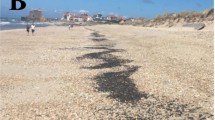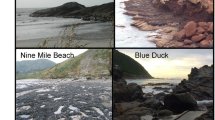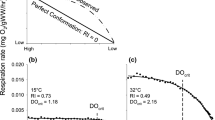Abstract
Heat-related mass mortalities and local extinctions are expected to rise as the frequency, duration, and intensity of extreme heat events increase due to climate change, particularly in the case of sessile or sedentary species that cannot relocate. Little is known, however, of how biotic factors, such as the size and non-motile behaviour of individuals, contribute to small-scale variation in susceptibility to heat-related mortality during such events. We used infrared thermography to investigate how manipulated mussel bed size and the size structure of individuals within beds influence small-scale variability in the body temperatures of two intertidal mussel species with different thermoregulatory behaviours (gaping vs. non-gaping) during simulated extreme heat conditions. At times, body temperatures of small individuals reached higher temperatures than large individuals, irrespective of mussel bed size, though this was more apparent for the non-gaping species. Average body temperatures and heating rates of individuals within large mussel beds were generally greater than for individuals within small mussel beds, irrespective of species or individual size. This pattern seems to reflect an effect of the greater circumference/area ratio for small mussel beds as individuals on the windward side of all beds displayed convective cooling and body temperatures 3–5 °C cooler than those on the leeward side. Such high levels of inter-individual variability in body temperatures at small spatial scales suggest the need for a greater appreciation and inclusion of biotic factors in assessing susceptibility of populations to climate change.




Similar content being viewed by others
References
Allen CD, Macalady AK, Chenchouni H et al (2010) A global overview of drought and heat-induced tree mortality reveals emerging climate change risks for forests. For Ecol Manage 259:660–684
Angilletta MJ Jr, Niewiarowski PH, Navas CA (2002) The evolution of thermal physiology in ectotherms. J therm Biol 27:249–268
Bell G (2013) Evolutionary rescue and the limits of adaptation. Philos Trans Roy Soc B 368:20120080
Biastoch A, Böning CW (2013) Anthropogenic impact on Agulhas leakage. Geophys Res Lett 40:1138–1143
Bownes SJ, McQuaid CD (2006) Will the invasive mussel Mytilus galloprovincialis Lamarck replace the indigenous Perna perna L. on the south coast of South Africa? J Exp Mar Biol Ecol 338:140–151
Branch GM, Steffani CN (2004) Can we predict the effects of alien species? A case-history of the invasion of South Africa by Mytilus galloprovincialis (Lamarck). J Exp Mar Biol Ecol 300:189–215
Carlson SM, Cunningham CJ, Westley PAH (2014) Evolutionary rescue in a changing world. Trends Ecol Evol 29:521–530
Chapperon C, Seuront L (2012) Keeping warm in the cold: on the thermal benefits of aggregation behaviour in an intertidal ectotherm. J Therm Biol 37:640–647
Denny MW, Dowd WW, Bilir L, Mach KJ (2011) Spreading the risk: small-scale body temperature variation among intertidal organisms and its implications for species persistence. J Exp Mar Biol Ecol 400:175–190
Harley CDG (2008) Tidal dynamics, topographic orientation, and temperature-mediated mass mortalities on rocky shores. Mar Ecol Prog Ser 371:37–46
Harris JM, Branch GM, Elliott BL, Currie B, Dye AH, McQuaid CD, Tomalin BJ, Velasquez C (1998) Spatial and temporal variability in recruitment of intertidal mussels around the coast of southern Africa. S Afr J Zool 33:1–11
Helmuth B (1998) Intertidal mussel microclimates: predicting the body temperature of a sessile invertebrate. Ecol Monogr 68:51–74
Helmuth B, Mieszkowska N, Moore P, Hawkins SJ (2006) Living on the edge of two changing worlds: forecasting the responses of rocky intertidal ecosystems to climate change. Annu Rev Ecol Syst 37:373–404
Helmuth B, Broitman BR, Yamane L, Gilman SE, Mach K, Mislan KAS, Denny MW (2010) Organismal climatology: analysing environmental variability at scales relevant to physiological stress. J Exp Biol 213:995–1003
Helmuth B, Yamane L, Lalwani S, Matzelle A, Tockstein A, Gao N (2011) Hidden signals of climate change in intertidal ecosystems: what (not) to expect when you are expecting. J Exp Mar Biol Ecol 400:191–199
Hughes TP, Baird AH, Bellwood DR et al (2003) Climate change, human impacts, and the resilience of coral reefs. Science 301:929–933
Jimenez AG, Jayawardene S, Alves S, Dallmer J, Dowd WW (2015) Micro-scale environmental variation amplifies physiological variation among individual mussels. Proc R Soc B 282:20152273
Jungerstam J, Erlandsson J, McQuaid CD, Porri F, Westerbom M, Kraufvelin P (2014) Is habitat amount important for biodiversity in rocky shore systems? A study of South African mussel assemblages. Mar Biol 161:1507–1519
Lathlean JA, Ayre DJ, Minchinton TE (2012) Using infrared imagery to test for quadrat-level temperature variation and effects on the early life history of a rocky-shore barnacle. Limnol Oceanogr 57:1279–1291
Lathlean JA, Ayre DJ, Minchinton TE (2013) Temperature variability at the larval scale affects early survival and growth of an intertidal barnacle. Mar Ecol Prog Ser 475:155–166
Lathlean JA, Seuront L, McQuaid CD, Ng TPT, Zardi GI, Nicastro KR (2016) Cheating the locals: invasive mussels steal and benefit from the cooling effect of indigenous mussels. PLoS ONE 11(3):e0152556. doi:10.1371/journal.pone.0152556
Marshall DJ, Chua T (2012) Boundary layer convective heating and thermoregulatory behaviour during aerial exposure in the rocky eulittoral fringe snail Echinolittorina malaccana. J Exp Mar Biol Ecol 430:25–31
Marshall DJ, McQuaid CD, Williams GA (2010) Non-climatic thermal adaptation: implications for species’ responses to climate warming. Biol Lett 6:669–673
McKechnie AE, Wolf BO (2010) Climate change increases the likelihood of catastrophic avian mortality events during extreme heat waves. Biol Lett 6:253–256
McQuaid CD, Porri F, Nicastro KR, Zardi GI (2015) Simple, scale-dependent patterns emerge from complex effects—an example from the intertidal mussels Mytilus galloprovincialis and Perna perna. Oceanogr Mar Biol Ann Rev 53:127–156
Mislan KAS, Wethey DS (2015) A biophysical basis for patchy mortality during heat waves. Ecology 96:902–907
Nicastro KR, Zardi GI, McQuaid CD, Stephans L, Radloff S, Blatch GL (2010) The role of gaping behaviour in habitat partitioning between coexisting intertidal mussels. BMC Ecol 10:17
Nicastro KR, Zardi GI, McQuaid CD, Pearson GA, Serrao EA (2012) Love thy neighbour: group properties of gaping behaviour in mussel aggregation. PLoS ONE 7(10):e47382. doi:10.1371/journal.pone.0047382
Oswald EM, Rood RB (2014) A trend analysis of the 1930–2010 extreme heat events in the Continental United States. J Appl Meteorol Climatol 53:565–582
Perkins SE, Alexander LV (2013) On the measurement of heat waves. J Clim 26:4500–4517
Pincebourde S, Sanford E, Helmuth B (2013) Survival and arm abscission are linked to regional heterothermy in an intertidal sea star. J Exp Biol 216:2183–2191
Seabra R, Wethey DS, Santos AM, Lima FP (2011) Side matters: microhabitat influence on intertidal heat stress over a large geographical scale. J Exp Mar Biol Ecol 400:200–208
Seuront L, Ng TPT (2016) Standing in the sun: infrared thermography reveals distinct thermal regulatory behaviours in two tropical high-shore littorinids snails. J Molluscan Stud 1–5:336–340. doi:10.1093/mollus/eyv058
Somero GN (2002) Thermal physiology and vertical zonation of intertidal animals: optima, limits and costs of living. Integr Comp Biol 42:780–789
Svane I, Ompi M (1993) Patch dynamics in beds of the blue mussel Mytilus edulis L.: effects of site, patch size, and position within a patch. Ophelia 37:187–202
Svane I, Setyobudiandi I (1996) Diversity of associated fauna in beds of the blue mussel Mytilus edulis L.: effects of location, patch size, and position with a patch. Ophelia 45:39–53
Swart NC, Fyfe JC (2012) Observed and simulated changes in the Southern Hemisphere surface westerly wind-stress. Geophys Res Lett 39:L16711
Tomalin BJ, Kyle R (1998) Subsistence and recreational mussel (Perna perna) collecting in KwaZulu-Natal, South Africa: fishing mortality and precautionary management. S Afr J Zool 33:12–22
Wernberg T, Smale DA, Tuya F, Thomsen MS, Langlois TJ, De Bettignies T, Bennett S, Rousseaux CS (2013) An extreme climatic event alters marine ecosystem structure in a global biodiversity hotspot. Nat Clim Chang 3:78–82
Williams GA, De Pirro M, Leung KMY, Morritt D (2005) Physiological responses to heat stress on a tropical shore: the benefits of mushrooming behaviour in the limpet Cellana grata. Mar Ecol Prog Ser 292:213–224
Wu L, Cai W, Zhang L, Nakamura H, Timmermann A, Joyce T, McPhaden MJ, Alexander M, Qui B, Visbeck M, Chang P, Giese B (2012) Enhanced warming over the global subtropical boundary currents. Nat Clim Chang 2:161–166
Zardi GI, Nicastro KR, McQuaid CD, Rius M, Porri F (2006) Hydrodynamic stress and habitat partitioning between indigenous (Perna perna) and invasive (Mytilus galloprovincialis) mussels: constraints of an evolutionary strategy. Mar Biol 150:79–88
Acknowledgments
We would like to thank Jaqui Trassierra for assistance in the field, Gray Williams for contributing to early discussions of the project and Elizabeth Lathlean for constructive comments on earlier versions of the manuscript. This work is based upon research supported by the South African Research Chairs Initiative of the Department of Science and Technology and the National Research Foundation. Funding, an Australian Research Council’s Discovery Project (project number DP0988554), and by Fundação para a Ciência e a Tecnologia (FCT; IF/01413/2014/CP1217/CT0004). School of Biological Sciences, The University of Hong Kong is also thanked for the travel support to T.P.T.N.
Author information
Authors and Affiliations
Corresponding author
Additional information
Responsible Editor: S. Connell.
Reviewed by A. Smith and an undisclosed expert.
Electronic supplementary material
Below is the link to the electronic supplementary material.
Rights and permissions
About this article
Cite this article
Lathlean, J.A., Seuront, L., McQuaid, C.D. et al. Size and position (sometimes) matter: small-scale patterns of heat stress associated with two co-occurring mussels with different thermoregulatory behaviour. Mar Biol 163, 189 (2016). https://doi.org/10.1007/s00227-016-2966-z
Received:
Accepted:
Published:
DOI: https://doi.org/10.1007/s00227-016-2966-z




